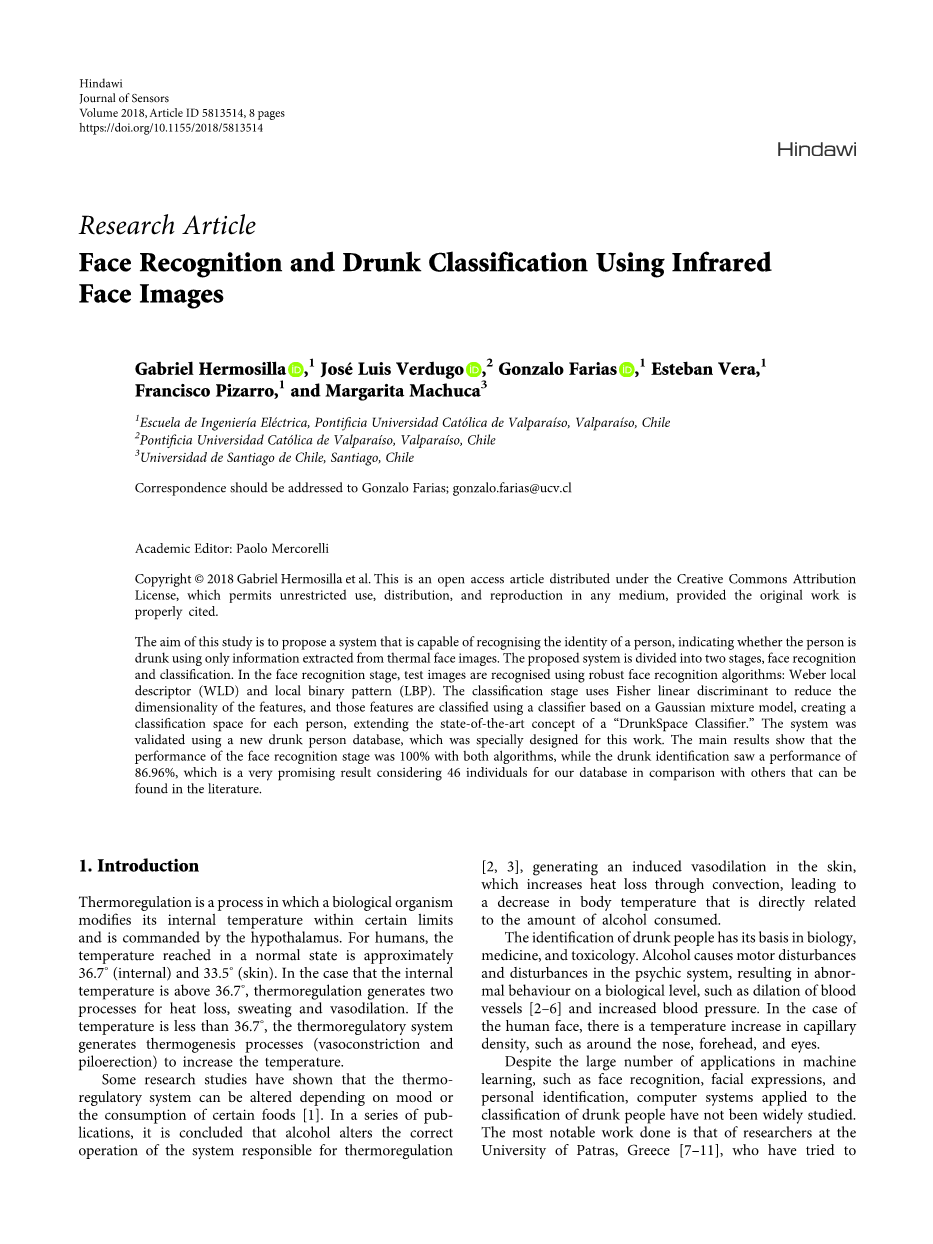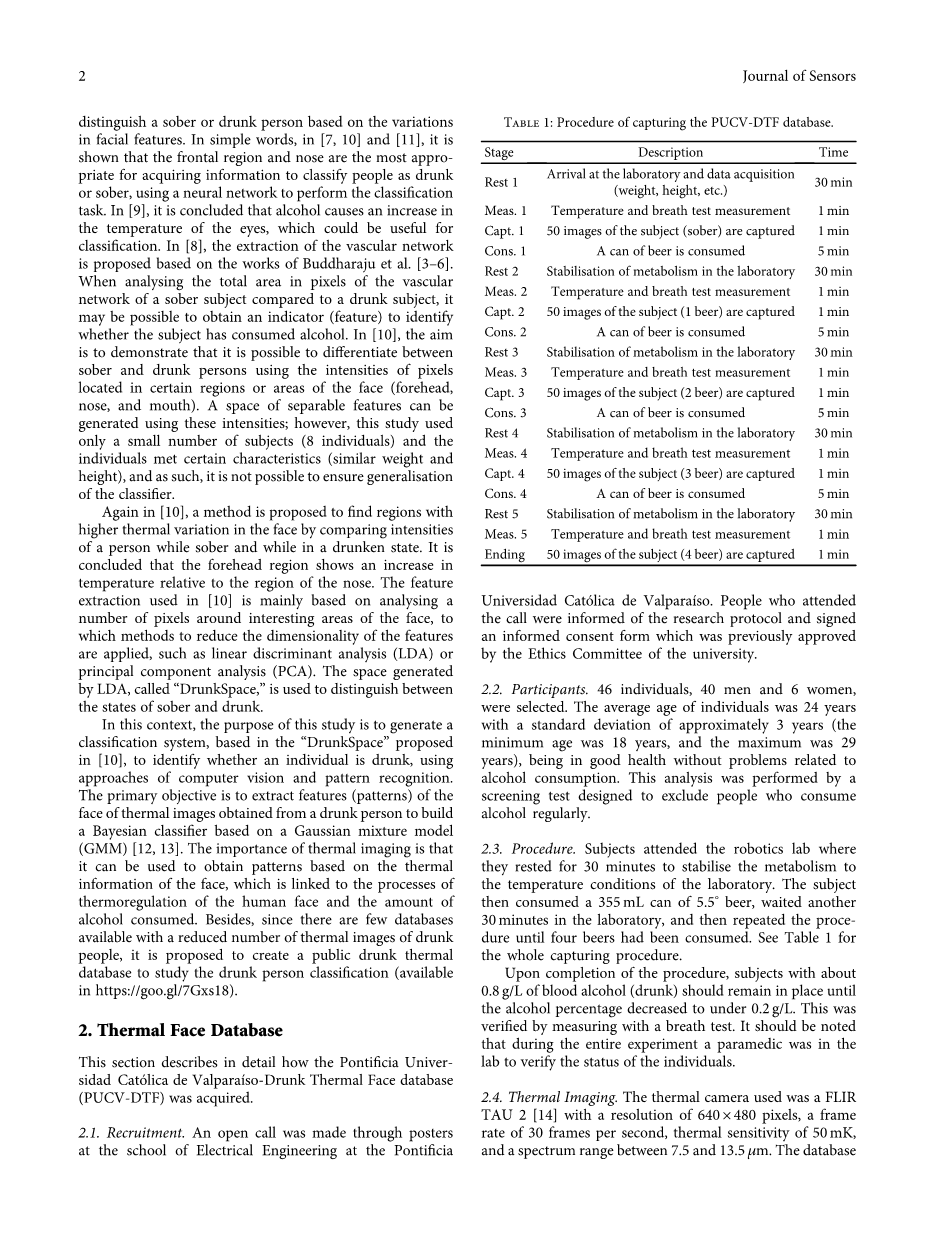

英语原文共 9 页,剩余内容已隐藏,支付完成后下载完整资料
Face Recognition and Drunk Classification Using Infrared Face Images
Abstract
The aim of this study is to propose a system that is capable of recognising the identity of a person, indicating whether the person is drunk using only information extracted from thermal face images. The proposed system is divided into two stages, face recognition and classification. In the face recognition stage, test images are recognised using robust face recognition algorithms: Weber local descriptor (WLD) and local binary pattern (LBP). The classification stage uses Fisher linear discriminant to reduce the dimensionality of the features, and those features are classified using a classifier based on a Gaussian mixture model, creating a classification space for each person, extending the state-of-the-art concept of a “DrunkSpace Classifier.” The system was validated using a new drunk person database, which was specially designed for this work. The main results show that the performance of the face recognition stage was 100% with both algorithms, while the drunk identification saw a performance of 86.96%, which is a very promising result considering 46 individuals for our database in comparison with others that can be found in the literature.
1. Introduction
Thermoregulation is a process in which a biological organism modifies its internal temperature within certain limits and is commanded by the hypothalamus. For humans, the temperature reached in a normal state is approximately 36.7° (internal) and 33.5° (skin). In the case that the internal temperature is above 36.7°, thermoregulation generates two processes for heat loss, sweating and vasodilation. If the temperature is less than 36.7°, the thermoregulatory system generates thermogenesis processes (vasoconstriction and piloerection) to increase the temperature.
Some research studies have shown that the thermo-regulatory system can be altered depending on mood or the consumption of certain foods [1]. In a series of pub-lications, it is concluded that alcohol alters the correct operation of the system responsible for thermoregulation[2, 3], generating an induced vasodilation in the skin,which increases heat loss through convection, leading to a decrease in body temperature that is directly related to the amount of alcohol consumed.
The identification of drunk people has its basis in biology, medicine, and toxicology. Alcohol causes motor disturbances and disturbances in the psychic system, resulting in abnor-mal behaviour on a biological level, such as dilation of blood vessels [2–6] and increased blood pressure. In the case of the human face, there is a temperature increase in capillary density, such as around the nose, forehead, and eyes.
Despite the large number of applications in machine learning, such as face recognition, facial expressions, and personal identification, computer systems applied to the classification of drunk people have not been widely studied. The most notable work done is that of researchers at the University of Patras, Greece [7–11], who have tried to distinguish a sober or drunk person based on the variations in facial features. In simple words, in [7, 10] and [11], it is shown that the frontal region and nose are the most appro-priate for acquiring information to classify people as drunk or sober, using a neural network to perform the classification task. In [9], it is concluded that alcohol causes an increase in the temperature of the eyes, which could be useful for classification. In [8], the extraction of the vascular network is proposed based on the works of Buddharaju et al. [3–6]. When analysing the total area in pixels of the vascular network of a sober subject compared to a drunk subject, it may be possible to obtain an indicator (feature) to identify whether the subject has consumed alcohol. In [10], the aim is to demonstrate that it is possible to differentiate between sober and drunk persons using the intensities of pixels located in certain regions or areas of the face (forehead, nose, and mouth). A space of separable features can be generated using these intensities; however, this study used only a small number of subjects (8 individuals) and the individuals met certain characteristics (similar weight and height), and as such, it is not possible to ensure generalisation of the classifier.
Again in [10], a method is proposed to find regions with higher thermal variation in the face by comparing intensities of a person while sober and while in a drunken state. It is concluded that the forehead region shows an increase in temperature relative to the region of the nose. The feature extraction used in [10] is mainly based on analysing a number of pixels around interesting areas of the face, to which methods to reduce the dimensionality of the features are applied, such as linear discriminant analysis (LDA) or principal component analysis (PCA). The space generated by LDA, called “DrunkSpace,” is used to distinguish between the states of sober and drunk.
In this context, the purpose of this study is to generate a classification system, based in the “DrunkSpace” proposed in [10], to identify whether an individual is drunk, using approaches of computer vision and pattern recognition. The primary objective is to extract features (patterns) of the face of thermal images obtained from a drunk person to build a Bayesian classifier based on a Gaussian mixture model (GMM) [12, 13]. The importance of thermal imaging is that it can be used to obtain patterns based on the thermal information of the face, which is linked to the processes of thermoregulation of the human face and the amount of alcohol consumed. Besi
全文共51581字,剩余内容已隐藏,支付完成后下载完整资料
资料编号:[13344],资料为PDF文档或Word文档,PDF文档可免费转换为Word
以上是毕业论文外文翻译,课题毕业论文、任务书、文献综述、开题报告、程序设计、图纸设计等资料可联系客服协助查找。


